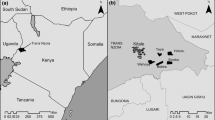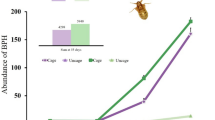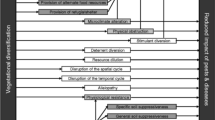Abstract
Pest control by wild arthropods is an important ecosystem service in fruit crops, especially due to markets that value minimal pesticide use. Techniques to augment on-farm habitat for wild arthropods have focused on flowering ground cover planted within orchards and hedgerows on field borders. However, natural enemies found in groundcover often do not favor tree canopy habitat. Conversely, while hedgerows can effectively provide natural enemies that prefer woody microhabitats, their impact diminishes away from field edges. Shrub crops interplanted within orchards could resolve both problems, providing woody habitat for natural enemies directly adjacent to target crop trees. In a multi-layer agroforestry system in Illinois, we vacuum sampled arthropod communities across layers and recorded vegetation characteristics and pest damage on apples. Using generalized linear models, information theoretic model selection, and non-metric multidimensional scaling, we evaluated the effects of three shrub treatments (raspberries, hazelnuts, and both species) on pest and natural enemy guilds in apple trees and shrubs, and on the frequency of pest damage on apples. Shrub composition was an important predictor of arthropod communities on shrubs. However, shrub treatment had only minor impacts on arthropods in apple canopies, indicating the habitats are less similar than anticipated. While two arthropod guilds in apple canopies were linked to pest damage frequency, neither was sensitive to changes in the shrub layer. Results suggest that shrub crop interplanting does not inherently resolve the ecological complexities that impede existing approaches in conservation biological control.





Similar content being viewed by others
References
Anderson DR (2007) Model based inference in the life sciences: a primer on evidence. Springer Science & Business Media, New York
Arnault I (2016) Foliar application of microdoses of sucrose to reduce codling moth Cydia pomonella L. (Lepidoptera: Tortricidae) damage to apple trees. Pest Manag Sci 72:1901–1909
Begg GS et al (2016) A functional overview of conservation biological control. Crop Protect 97:145–158
Bolker B, Team R (2010) bbmle: Tools for general maximum likelihood estimation R package version 09 5
Bortolotto O et al (2016) Distance from the edge of forest fragments influence the abundance of aphidophagous hoverflies (Diptera: Syrphidae) in wheat fields. Acta Sci Agron 38:157–164
Brose U (2003) Bottom-up control of carabid beetle communities in early successional wetlands: mediated by vegetation structure or plant diversity? Oecologia 135:407–413
Brown M, Glenn D (1999) Ground cover plants and selective insecticides as pest management tools in apple orchards. J Econ Entomol 92:899–905
Brown M, Mathews C (2007) Conservation biological control of rosy apple aphid, Dysaphis plantaginea (Passerini), in eastern North America.”. Environ Entomol 36:1131–1139
Bugg RL, Waddington C (1994) Using cover crops to manage arthropod pests of orchards: a review Agric. Ecosyst Environ 50:11–28
Burnham KP, Anderson DR (2002) Model selection and multimodel inference: a practical information–theoretic approach. Springer Science & Business Media, New York
Calabuig A, Garcia-Marí F, Pekas A (2015) Ants in citrus: impact on the abundance, species richness, diversity and community structure of predators and parasitoids. Agric Ecosyst Environ 213:178–185
Coli WM, Ciurlino RA, Hosmer T (1994) Effect of understory and border vegetation composition on phytophagous and predatory mites in Massachusetts commercial apple orchards. Agric Ecosyst Environ 50:49–60
Daubenmire R (1959) A canopy-coverage method of vegetational analysis. Northwest Sci 33:43–64
Debras J-F, Senoussi R, Rieux R, Buisson E, Dutoit T (2008) Spatial distribution of an arthropod community in a pear orchard (southern France): identification of a hedge effect. Agric Ecosyst Environ 127:166–176
Denno RF, Peterson MA (2000) Caught between the devil and the deep blue sea, mobile planthoppers elude natural enemies and deteriorating host plants. Am Entomol 46:95–109
Denno RF, Gratton C, Peterson MA, Langellotto GA, Finke DL, Huberty AF (2002) Bottom-up forces mediate natural-enemy impact in a phytophagous insect community. Ecology 83:1443–1458
Dong J et al (2005) Evaluation of the Lucerne cover crop for improving biological control of Lyonetia clerkella (Lepidoptera: Lyonetiidae) by means of augmenting its predators in peach orchards. Great Lakes Entomol 28:186–199
Eilers EJ, Klein A-M (2009) Landscape context and management effects on an important insect pest and its natural enemies in almond. Biol Control 51:388–394
Erlandson LW, Obrycki JJ (2010) Predation of immature and adult Empoasca fabae (Harris)(Hemiptera: Cicadellidae) by three species of predatory insects. J Kans Entomol Soc 83:1–6
Fréchette B, Cormier D, Chouinard G, Vanoosthuyse F, Lucas E (2008) Apple aphid, Aphis spp. (Hemiptera: Aphididae), and predator populations in an apple orchard at the non-bearing stage: the impact of ground cover and cultivar Eur. J Entomol 105:521
Gareau TLP, Letourneau DK, Shennan C (2013) Relative densities of natural enemy and pest insects within California hedgerows. Environ Entomol 42:688–702
Grettenberger IM, Tooker JF (2016) Variety mixtures of wheat influence aphid populations and attract an aphid predator. Arthropod Plant Interact 11:133–146
Haddad NM, Tilman D, Haarstad J, Ritchie M, Knops JM (2001) Contrasting effects of plant richness and composition on insect communities: a field experiment. Am Nat 158:17–35
Horton DR, Jones VP, Unruh TR (2009) Use of a new immunomarking method to assess movement by generalist predators between a cover crop and tree canopy in a pear orchard. Am Entomol 55:49–56
Janssen A, Sabelis MW, Magalhães S, Montserrat M, Van der Hammen T (2007) Habitat structure affects intraguild predation. Ecology 88:2713–2719
Knops JM et al (1999) Effects of plant species richness on invasion dynamics, disease outbreaks, insect abundances and diversity. Ecol Lett 2:286–293
Koricheva J, Mulder CP, Schmid B, Joshi J, Huss-Danell K (2000) Numerical responses of different trophic groups of invertebrates to manipulations of plant diversity in grasslands. Oecologia 125:271–282
Lamp WO, Nielsen GR, Danielson SD (1994) Patterns among host plants of potato leafhopper, Empoasca fabae (Homoptera: Cicadellidae). J Kans Entomol Soc 67:354–368
Landis DA, Wratten SD, Gurr GM (2000) Habitat management to conserve natural enemies of arthropod pests in agriculture. Annu Rev Entomol 45:175–201
Lenth RV, Hervé M (2013) lsmeans: Least-squares means R package version 2:11
Letourneau DK et al (2011) Does plant diversity benefit agroecosystems? A synthetic review. Ecol Appl 21:9–21
Lovell ST, Dupraz C, Gold M, Jose S, Revord R, Stanek E, Wolz KJ (2017) Temperate agroforestry research: considering multifunctional woody polycultures and the design of long-term field trials. Agrofor Syst. https://doi.org/10.1007/s10457-017-0087-4
Madsen HF, Jack ID (1966) The relation of thrips to pansy spot on apples. Can Entomol 98:903–908
Markó V, Jenser G, Mihályi K, Hegyi T, Balázs K (2012) Flowers for better pest control? Effects of apple orchard groundcover management on mites (Acari), leafminers (Lepidoptera, Scitellidae), and fruit pest. Biocontrol Sci Technol 22:39–60
Miliczky E et al (2007) Spatial patterns of western flower thrips (Thysanoptera: Thripidae) in apple orchards and associated fruit damage. J Entomol Soc B. C. 104:25–34
Morandin L, Long R, Pease C, Kremen C (2011) Hedgerows enhance beneficial insects on farms in California’s Central Valley. Calif Agric 65:197–201
Oksanen J, Kindt R, Legendre P, O’Hara B, Stevens MHH, Oksanen MJ, Suggests M (2007) The vegan package. Commun Ecol Packag 10:631–637
Otte D (1976) Species richness patterns of New World desert grasshoppers in relation to plant diversity. J Biogeogr 3:197–209
Paredes D, Cayuela L, Campos M (2013) Synergistic effects of ground cover and adjacent vegetation on natural enemies of olive insect pests. Agric Ecosyst Environ 173:72–80
Paredes D, Cayuela L, Gurr GM, Campos M (2015) Is ground cover vegetation an effective biological control enhancement strategy against olive pests? PLoS ONE 10:e0117265
R Core Team (2016) A language and environment for statistical computing. R Foundation for statistical computing, 2015; Vienna, Austria
Rieux R, Simon S, Defrance H (1999) Role of hedgerows and ground cover management on arthropod populations in pear orchards. Agric Ecosyst Env 73:119–127
Russell EP (1989) Enemies hypothesis: a review of the effect of vegetational diversity on predatory insects and parasitoids. Env Entomol 18:590–599
Sigsgaard L et al (2017) Mass release of Trichogramma evanescens and T cacoeciae can reduce damage by the apple codling moth Cydia pomonella in organic orchards under pheromone disruption. Insects 8:41
Silva E, Franco J, Vasconcelos T, Branco M (2010) Effect of ground cover vegetation on the abundance and diversity of beneficial arthropods in citrus orchards. Bull Entomol Res 100:489–499
Simon S, Bouvier J-C, Debras J-F, Sauphanor B (2010) Biodiversity and pest management in orchard systems. A review. Agron Sustain Dev 30:139–152
Stewart AJ, Wright AF (1995) A new inexpensive suction apparatus for sampling arthropods in grassland. Ecol Entomol 20:98–102
Straub CS et al (2013) Influence of nonhost plant diversity and natural enemies on the potato leafhopper, Empoasca fabae, and pea aphid, Acyrthosiphon pisum, in alfalfa. J Pest Sci 86:235–244
Tscharntke T et al (2016) When natural habitat fails to enhance biological pest control—Five hypotheses. Biol Conserv 204:449–458
Tuovinen T (1994) Influence of surrounding trees and bushes on the phytoseiid mite fauna on apple orchard trees in Finland Agric. Ecosyst Environ 50:39–47
Unruh TR, Pfannenstiel RS, Peters C, Brunner JF, Jones VP (2012) Parasitism of leafrollers in Washington fruit orchards is enhanced by perimeter plantings of rose and strawberry. Biol Control 62:162–172
Venables WN, Ripley BD (2013) Modern applied statistics with S-PLUS. Springer Science & Business Media, New York
Wilson S, Smith J, Purcell A III (1993) An inexpensive vacuum collector for insect sampling. Entomol News 104:203–208
Wolz KJ, Branham BE, DeLucia EH (2018a) Reduced nitrogen losses after conversion of row crop agriculture to alley cropping with mixed fruit and nut trees Agric. Ecosyst Environ 258:172–181
Wolz KJ et al (2018b) Frontiers in alley cropping: transformative solutions for temperate agriculture. Glob Change Biol 24:883–894
Acknowledgements
This work was supported by the Agroecology and Sustainable Agriculture Program at the University of Illinois Urbana-Champaign and the National Institute of Food and Agriculture, United States Department of Agriculture, under Award Number ILLU-875-918. Funding sources had no involvement in the conception, design, or implementation of the study. We’d also like to thank Alex Hiatt, Di Ye, Nisarg Shah, Iris Daiber, Kat Rola, and Victoria Wallace, the field and lab technicians who helped conduct this research, as well as Ron Revord, Dane Nelson, and Alex Hiatt, who established and managed our research site, and Jane Capozelli, Jaime Coon, Samniqueka Halsey, Scott Nelson, Timothy Swartz, Lawrence Hanks, Brenda Molano-Flores, and Michelle Wander for comments on the manuscript.
Author information
Authors and Affiliations
Corresponding author
Rights and permissions
About this article
Cite this article
Kranz, A.J., Wolz, K.J. & Miller, J.R. Effects of shrub crop interplanting on apple pest ecology in a temperate agroforestry system. Agroforest Syst 93, 1179–1189 (2019). https://doi.org/10.1007/s10457-018-0224-8
Received:
Accepted:
Published:
Issue Date:
DOI: https://doi.org/10.1007/s10457-018-0224-8




